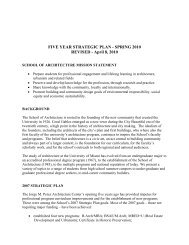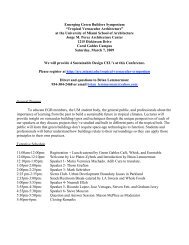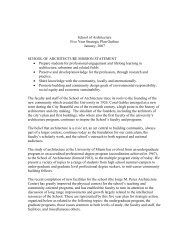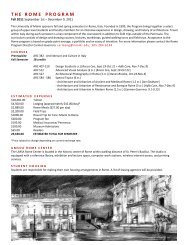Full Report - Knight Program in Community Building
Full Report - Knight Program in Community Building
Full Report - Knight Program in Community Building
Create successful ePaper yourself
Turn your PDF publications into a flip-book with our unique Google optimized e-Paper software.
HURLEY | THE PUBLIC PROCESS 7Stages <strong>in</strong> the ProcessWith<strong>in</strong> the field of consensus-build<strong>in</strong>g, there are well-recognized stages <strong>in</strong> theprocess: (1) assessment/conven<strong>in</strong>g, (2) build<strong>in</strong>g the agreement, (3) implementation,and (4) evaluation. These stages are not purely l<strong>in</strong>ear. Activities <strong>in</strong> one stage maylead participants to revisit an “earlier” stage. However, these stages describe tasksthat must be completed, and provide a framework for understand<strong>in</strong>g the overall arcof the process.Each of these stages relates to aspects of us<strong>in</strong>g charrettes <strong>in</strong> a plann<strong>in</strong>g process.I will discuss each stage <strong>in</strong> turn, describ<strong>in</strong>g the tasks undertaken as part of a consensus-build<strong>in</strong>gprocess, and then discuss<strong>in</strong>g how they relate to charrettes.Step 1: Assessment/Conven<strong>in</strong>gThe assessment/conven<strong>in</strong>g stage is crucial <strong>in</strong> consensus-build<strong>in</strong>g. This stagesets the tone for the entire consensus-build<strong>in</strong>g process. Common tasks undertaken<strong>in</strong> this stage <strong>in</strong>clude:• Stakeholder Analysis• Determ<strong>in</strong>e if collaborative process is appropriate• Secure commitment from stakeholders to participate• Arrange first event/meet<strong>in</strong>g• Agree on ground rules, <strong>in</strong>clud<strong>in</strong>g a decision rule• Choose a facilitator• Stakeholder Tra<strong>in</strong><strong>in</strong>g (if appropriate)“Stakeholder Analysis,” a technique developed as an application of systems theory,has three primary components: identify<strong>in</strong>g the stakeholders; identify<strong>in</strong>g the <strong>in</strong>terests,<strong>in</strong>fluences, resources, and power that those stakeholders have and can use; and mapp<strong>in</strong>gthe relationships among different stakeholders. Identify<strong>in</strong>g the stakeholders simplymeans answer<strong>in</strong>g as completely as possible two questions: “Who can affect the project?”and “Who is affected by the project?” The first question is strategic. Anyone whocan affect the outcome of the plann<strong>in</strong>g and development process should be <strong>in</strong>volvedas early as possible. The second question is driven by concerns about equity. Thesecond and third components of stakeholder analysis provide <strong>in</strong>formation abouthow to <strong>in</strong>fluence the “system,” the group of people who have a relationship to aproject. Some people will need to be <strong>in</strong>volved early and often, some only once,some at certa<strong>in</strong> po<strong>in</strong>ts <strong>in</strong> the decision-mak<strong>in</strong>g process. A thorough stakeholderanalysis prevents unpleasant surprises later <strong>in</strong> the project.
















